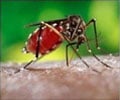US researchers have found that locking the parasites within infected blood cells could also prove an effective way to contain malaria.

The findings of Harvard School of Public Health (HSPH) researchers and colleagues could offer a new drug target for fighting malaria.
Working with the malaria parasite and human blood in test tubes and lab dishes, the research team identified a single fast-acting protein in the parasite that enables it and several dozen of its offspring to escape from a human red blood cell in preparation for quick invasion of many more healthy blood cells. Eliminating that protein traps the parasites in the cell.
After an infected mosquito bites a person, malaria parasites move into the liver, where they silently mature and multiply within weeks. Malaria parasites make people sick weeks or months later when they enter red blood cells and begin an exponential expansion. In a single cell, a parasite produces up to 32 offspring in about two days, which burst out to infect more red blood cells.
"This is the stage where things have to happen very fast for the parasite," said senior author Manoj Duraisingh, HSPH assistant professor of immunology and infectious diseases and senior author of the paper in the May 14 Science. "The parasite doesn't like to spend much time outside the cell. It grows and matures, and immediately following rupture, enters a new cell. It was a surprise that this protein kinase, which we thought would be involved in red blood cell invasion, turns out to be essential for the parasite getting out of the cell."
The study helps define the exit of the parasite from a blood cell as a highly choreographed process and distinguishes the egress and invasion steps, the researchers said.
Advertisement
Even better, the protein is found in the parasite and in plants, but not in humans, which means a drug targeted to that protein may be less toxic for people. The protein belongs to a family of Plasmodium falciparum calcium-dependent protein kinases, or PfCDPK5 for short in this case. Other members of the family have been implicated in parasite egress of red blood cells, but this is the first study using a genetic technique to validate a protein critical for parasite egress of red blood cells, according to the researchers.
Advertisement
The paper also demonstrates the usefulness of a new tool that can be used to evaluate additional members of the kinase family, as well as other signaling pathways that regulate key events in the blood stage of malaria infection. As of 2002, "we have a malaria genome of about 6,000 genes," said Duraisingh. "We need a means of prioritizing specific gene candidates for further drug development."
The method, first developed in a mammalian cell culture system by co-author Thomas Wandless of Stanford University, allows scientists to analyze the function of certain proteins and to identify other potential therapeutic targets in the malaria parasite, the researchers said.
As adapted for this study, Dvorin and his colleagues reverse-engineered candidate genes to make faulty proteins that would only survive in the presence of a stabilizing chemical. Without that constant protection, the protein is eliminated from the parasite.
"For 24 hours a day, 7 days a week, we grew the parasites in the presence of the stabilizing chemical," Dvorin said. "After the parasites invaded new red blood cells, we washed away the stabilizing drug. Even though the parasites seemed to develop just fine, they were unable to leave the red blood cell."
Interestingly, the team's work also produced an elusive scientific tool for their colleagues in the vaccine field: Mature invasive parasites. "One of the experiments in the paper mechanically releases the parasites, which have matured into virulent and invasive forms," Duraisingh said. "People have been trying to get viable parasites in this form for study. This is a great resource for vaccine studies."
Source-Medindia
GPL











